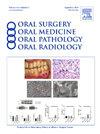慢性增生性念珠菌病的概况-长期随访显示恶性转化的低风险
IF 1.9
3区 医学
Q2 DENTISTRY, ORAL SURGERY & MEDICINE
Oral Surgery Oral Medicine Oral Pathology Oral Radiology
Pub Date : 2025-07-21
DOI:10.1016/j.oooo.2025.04.018
引用次数: 0
摘要
慢性增生性念珠菌病(CHC)是一种罕见的病变,最近被世卫组织从潜在的恶性疾病列表中删除,尽管其与白斑的区分存在争议。本研究的目的是调查CHC与无发育不良的白斑(LKP)的临床表现、全身因素和长期恶性转化率。材料与方法回顾性病例对照研究2000 - 2013年间诊断为CHC和LKP的非发育不良患者。研究人员创建了一个数据库,并对来自同一患者的其他活组织检查进行了检索,以寻找截至2022年的口腔恶性肿瘤记录。结果本研究纳入116例患者,其中CHC 62例,LKP 54例,年龄、性别、地理位置与CHC组相匹配;所有活检均为不典型增生阴性。舌和颊粘膜最常受累。CHC中出现白色病变的患者明显较少,溃疡或外生性病变较多(P = )。006和P = 。003年,分别)。CHC患者有头颈部(H&;N)恶性肿瘤病史(P = .001)、化疗(P = .019)、放疗(P = . 026)和免疫相关疾病(P = .03)的发生率明显更高(P = .001)。在非h&;N恶性肿瘤和其他系统性疾病的评估频率上没有发现显著差异。随访期间,CHC 2例(3.2%)患者在CHC原发部位发生恶性转化,其中1例为既往OSCC复发。此外,2例(3.2%)患者新诊断为OSCC, 3例(4.8%)患者在其他部位有OSCC复发。在LKP中,2例(3.7%)为新诊断的OSCC, 1例(1.7%)为原活检部位。各组间无显著差异。结论免疫相关疾病的医学背景、H&;N恶性肿瘤、H&;N放疗和化疗可能是CHC易感因素。CHC病变的恶性转化率较低,与未发育不良的LKP相似,其转化率低于预期。本文章由计算机程序翻译,如有差异,请以英文原文为准。
The profile of chronic hyperplastic candidiasis—long-term follow-up demonstrating low risk for malignant transformation
Introduction
Chronic Hyperplastic Candidiasis (CHC) is a rare lesion, recently removed by WHO from the list of potentially malignant disorders, although its differentiation from leukoplakia is controversial. The aims of this study were investigation of clinical presentation, systemic factors, and long-term malignant transformation rate in CHC vs leukoplakia without dysplasia (LKP).
Material and Methods
Retrospective case-controlled study of CHC and LKP without dysplasia, diagnosed between 2000 and 2013. A database was created, and additional biopsies from the same patients were searched for records of oral malignancy up to 2022.
Results
The study included 116 patients, 62 CHC, 54 LKP, matched for age, gender, and location with the CHC group; all biopsies were negative for dysplasia. The tongue and buccal mucosa were most frequently involved. In CHC, significantly fewer patients presented white lesions, more lesions were ulcerated or exophytic (P = .006 and P = .003, respectively). History of head and neck (H&N) malignancy was significantly more frequent in CHC (P = .001), as were chemotherapy (P = .019), radiotherapy P = .026), and immune-related conditions (P = .03). No significant differences were found in the frequency of non-H&N malignancy and other systemic condition evaluated. Within the follow-up period, in CHC 2 (3.2%) patients had a malignant transformation at the original site of CHC, of which one was a recurrence of previous OSCC. In addition, 2 (3.2%) patients were newly diagnosed with OSCC and 3 (4.8%) had a recurrence of OSCC at other locations. In LKP, 2 (3.7%) had newly diagnosed OSCC, 1 (1.7%) at the site of the original biopsy. No significant differences were found between groups.
Conclusions
Medical background of immune-related conditions, H&N malignancy, radiotherapy to H&N, and chemotherapy may play a role in predisposing for CHC. Malignant transformation rate in CHC lesions was low, similar to LKP without dysplasia, and represented a lower transformation rate than expected.
求助全文
通过发布文献求助,成功后即可免费获取论文全文。
去求助
来源期刊

Oral Surgery Oral Medicine Oral Pathology Oral Radiology
DENTISTRY, ORAL SURGERY & MEDICINE-
CiteScore
3.80
自引率
6.90%
发文量
1217
审稿时长
2-4 weeks
期刊介绍:
Oral Surgery, Oral Medicine, Oral Pathology and Oral Radiology is required reading for anyone in the fields of oral surgery, oral medicine, oral pathology, oral radiology or advanced general practice dentistry. It is the only major dental journal that provides a practical and complete overview of the medical and surgical techniques of dental practice in four areas. Topics covered include such current issues as dental implants, treatment of HIV-infected patients, and evaluation and treatment of TMJ disorders. The official publication for nine societies, the Journal is recommended for initial purchase in the Brandon Hill study, Selected List of Books and Journals for the Small Medical Library.
 求助内容:
求助内容: 应助结果提醒方式:
应助结果提醒方式:


